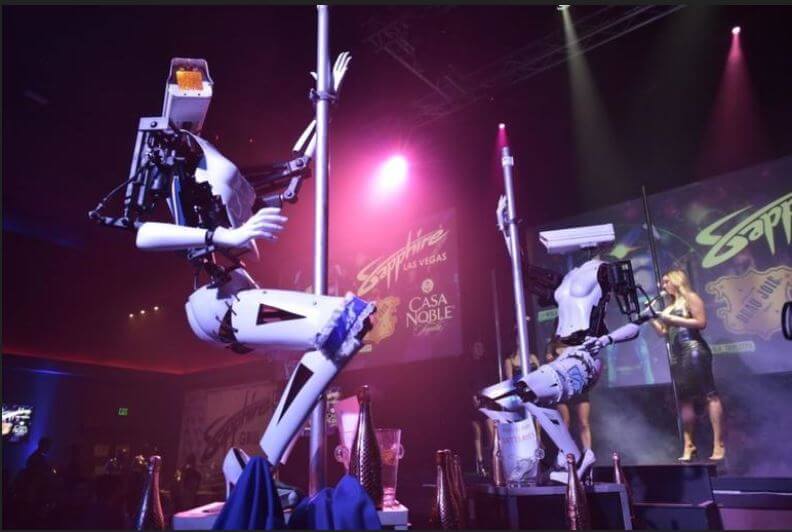Each year, the Consumer Electronics Show (CES) in Las Vegas reveals the latest innovations in consumer technologies. This year was no exception, as a plethora of new products were unveiled on the showroom floor of the Las Vegas Convention Center, including “rideables,” the Teslasuit, and a 3D metal printer. However, the most interesting product, unveiled at a Las Vegas strip club, was a pole dancing stripper robot.
The Sapphire Strip Club – which was not affiliated with CES – brought the stripper robots from London to provide entertainment to some of the more than 180,000 people who descend upon Vegas each year to attend the electronics show. And, for one week, the human women and the animatronic women danced side-by-side.
The club’s managing partner told The Daily Beast that more women are attending CES, and he thought the robot strippers would attract them to the club. While it’s not clear if his strategy was effective, the change seemed to amuse men who threw money at the robotic strippers instead of their human counterparts.
One person who was not amused is Lin Classon, the commercial product manager for hyperscale cloud at Ensono. “The robot stripper news made me outraged and sad,” Classon says. “It made me think about what Oprah said at the Golden Globes: how what we do today affects our children tomorrow, and that we’re fighting hard to bring up these children so that they are able to become leaders.”
Classon, who also spent more than six years as a product marketing manager at Google, is accustomed to being one of the few women in a male-dominated industry, and nowhere is this lack of gender diversity more apparent than in meetings and at major conferences and industry events. “For instance, just last November, during AWS re:Invent, (which hosts around 43,000 leaders and innovators in tech), I found myself wondering if I was the only woman in the audience,” Classon says. “The women’s restrooms at these events have virtually no lines.” While she jokes that she is grateful for quiet, empty, bathrooms at these types of conferences, on a more serious note she adds, “I’d gladly take a long line at the ladies’ room instead.”
Classon has been at Ensono for eight months, and believes the company makes it a priority to create a diverse workforce and foster an inclusive culture. “We currently have 56 women in leadership today, representing 23.3 percent of our leadership team globally,” she explains. “As I progress in my career path, I want to make sure to give back and contribute to the tech community as a whole, and by extension, contribute to the world as diversity brings about innovation – and we need to ensure that 50% of the population has a fair shot at it.”
A Boys Club Mentality
At times, there appears to be a lot of pushback in technology against women, but if so, Classon says she wants to believe the problem is a lack of awareness instead of active attempts at exclusion. “I believe the ‘pushback’ is fundamentally a pipeline problem, stemming from lack of access to support and opportunities,” Classon says. “To be productive, I think we should frame the discourse in such a way that it brings the issues to light and encourages an open dialogue and active participation from all sides to push for solutions.”
Click here to learn more about HER Circle!
So, would having robots compete against women in a strip club be a deliberate attempt at devaluing women and their contributions, or perhaps the result of ignorance? Classon interprets it more as a symptom of a larger problem. “I can’t fault the strip club owner for wanting to cater to his clientele – that’s a different discussion,” she says. “But we could and should question why ‘robot strippers’ and CES seem to go so naturally together.” In fact, Classon refers to some of the headlines regarding this event:
“Stripper robots made their debut in Las Vegas during CES 2018”
“Pole dancing stripper robots entertain industry”
“Pole-dancing robots appear in Las Vegas to spice up CES”
“The laissez-faire reception signifies a layer of assumptions being made here: (1) CES caters mostly to men, (2) CES is attended mostly by men, (3) It’s a boy’s club, (4) Boys will always be boys,” Classon explains.
From that perspective, she says it’s almost a no-brainer that a gentleman’s club would bring in robot strippers for the CES. “This reflects the underlying issues that have been plaguing CES for many years now.”
Closing the STEM Gender Gap
According to CBS Sacramento, the gender statistics at this year’s show were as follows: women were 20% of attendees, 2 of the 15 keynote speakers, and 25% of the approximately 900 speakers. “From the absence of a code of conduct, to the lack of female keynote speakers, the event makes women an afterthought and creates an uncomfortable environment for those outside the main demographic – it says you don’t belong, even though that may not be the intention,” Classon says.
Classon believes that the attempts by CES to address the robotic strippers continued the pattern of a lack of self-awareness. “Their reactive statement, instead of confronting head-on the historical gender disparity, simply disavowed the robot stripper show as not affiliated with CES,” Classon says. “When criticized again for the lack of female keynote speakers, CES blamed companies for ‘failing to elevate their female leadership.’”
Having women properly represented at events like CES can help to inspire other women to pursue STEM careers. Women earn 57.3% of all undergrad college degrees, but according to data from the National Science Board, only 17.9% of computer science degrees and 19.3% of engineering degrees are awarded to women.
The widespread acceptance of animatronic strippers is just one of the reasons we need more women in computer science and engineering. “Representations are important, not just for the other women currently in the industry or those who are considering entering the industry,” Classon explains. “They are even more important for bringing up the next generation of women engineers, inventors, and leaders, because you can’t be what you can’t see.”
Girls tend to lose interest in STEM subjects when they reach the teen years. Even those who enroll in college intent on pursuing a STEM degree can be sidetracked by such issues as isolation, and many end up transferring out of STEM. However, a recent study reveals that 100% of first-year women engineering students who had women peer mentors remained in the engineering program for the second year.
“Tech industry conferences need to showcase women in their keynotes – brilliant speakers who happen to be women are out there – they do exist,” Classon says. She recommends that tech conferences design programs that can connect female attendees with industry leaders who could serve as mentors and supporters. “To help better the industry, which ultimately is good for their business, conference organizers have the power and obligation to use their platform to encourage diversity and inclusion.”
image via Getty Images









